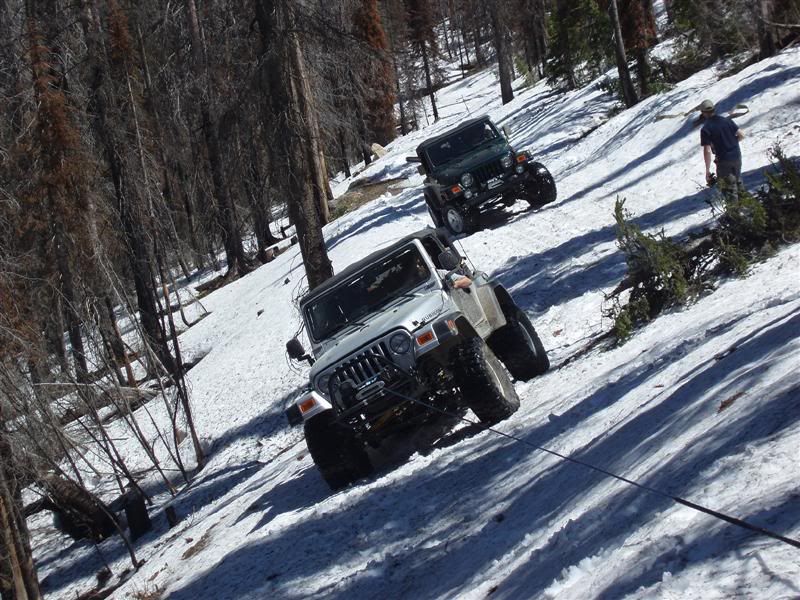tire chains for hard core winter trail rides
Tire chains come in many strengths & designs, just like tires. If your primary need is for emergency highway use on stock tires or slightly larger than stock tires there are a lot of places to buy inexpensive chains. For a 30" dia tire they will be built from 1/4" or 9/32" material, the cross treads will be on a 4 link spacing of the side chain and the cross treads will just be standard chain - no welded v-bars or spikes. These chains will be "general in size", built a bit on the sloppy side and require conventional side chain tensioners. They will be just fine for their intended purpose and worth their weight in gold going over a snowed-in mountain pass on the highway. You might keep them in your vehicle for 20 years before needing them. But that one time you reaaaaalllllly need them they will be invaluable.
But do yourself a favor. Don't think for a minute these can be used reliably off road in extended hard core wheeling. These types of chains are usually not robust enough, do not have enough cross treads and do not run v-bars or spikes of some sort which are necessary to create high pressure points in ice. Plus they are a sloppy "universal fit", i.e. a set will be for a "10x15" tire, cut a little big to fit ANY 10 x 15 tire, and require tensioners to keep them snug. On the jeep roads in NE PA where I wheel in the winter even the heavy duty truck type spring tensioners get ripped off inside an hour or two of trail ride. Usually without one becoming aware. I have had to use a metal detector to search the huge ice covered mud puddles for a slipped off chain because of this. These cheap chains should only be used off-road in a real pinch.
Tractor trailer chains are 5/16" material . Tougher than the China imported cheap stuff (1/4" & 9/32") sold on many web sites and stores. Cutting the 5/16" truck chains down to custom fit a specific tire eliminates need for chain tensioners and it is the goodness of fit which ultimately determines if the chains stay on your tires after the tensioners get ripped off. I do my primary wheeling in winter and found with many years of winter use to not even need tensioners once the chains are truly custom fitted to the specific tire size and brand (say a 38" Interco TSL).
The next step up is 2 link spacing of the cross treads instead of 4 link spacing like the "cheap stuff" one might have for emergency highway use. This instantly doubles the cost and weight because there are twice as many cross treads around the periphery of the tire. Again, 4 link spacing is fine for the emergency highway set of inexpensive chains. But if you plan on wheeling off-road in the winter do yourself a favor and invest in chains with cross treads at 2 link spacing. The extra grab on side hill traverses is amazing because you pretty much always have a cross chain under the tire at 2 link spacing. Too often people think tire chains are tire chains and do not even realize the difference between 4 link and 2 link spacing. Having started as a kid with little $$ running 4 link spaced chains I know from experience the huge difference between 2 and 4 link spacing on off road trails in the winter.
The next step up is welded v-bar cross chain. This design bites into ice with ease. It is about a 20% cost adder. But think about where you will be using the chains. If a trail has been run much in the winter there will be compressed snow (ice!) all over it. No matter how much you deflate your tires, rubber and ice do not mix on a 30 degree slope!! You need a localized high pressure contact point on your chains to bite into the iced over, compressed snow. Get the v-bars.
For true ICED OVER TRAILS the 2 link spacing of welded v-bar cross treads that are custom fitted is unbeatable. You will be running about 2.5 times the weight of chain per tire than the "inexpensive emergency highway style". But you will get trouble free ROBUST off-road reliability.
Once tires get into the 40" plus category it is time to step up to 3/8" material. This nearly doubles the cost, again over the 5/16" material. But the bigger tires put a lot more stress on the chains. If you want to play (reliably) you have to pay.
There are plenty of places that will try and sell you 9/32" non v-bar material (imported from China, too) on 4 link spacing for you 40/44 " dia tires. This is ridiculously unsafe. These are not custom fitted, require chain tensioners and are fragile indeed off-road. A 44 " tire chain like this will weigh maybe 30 pounds per tire and be priced accordingly (cheap). A properly built chain suitable for off road use on 40/44 inch dia tires will weigh in around 100 pounds, be constructed of 3/8" material, be at 2 link spacing and have welded v-bars or spikes of some sort to create high pressure bite points for ice. And these will also be priced accordingly to their weight (not cheap). Plus they will be fitted to the exact tire size and brand to prevent use of tensioners. You don't see SKIDDERS using tensioners, do you?
I saw a comment that aired down tires and wheel spin will out perform tire chains in deep snow. That is not my experience here in NE USA. Lots of people don't realize it but 4x4s running chains in deep snow (at least the heavy type usually seen in NE USA) don't even make it down to the ground if they are running a half decent size flotation tire for the weight of the vehicle. I have a 20 degree open field in back of my house where I play around in the snow. I can usually run up the hill about 3 times in the exact same tracks in about a foot of snow with chains on before I start contacting grass/earth under the snow. And with the chains I can start and stop at will anywhere on the slope. That is literally not possible without the chains. In really deep snow a bit of wheel spin is best but I keep it to a minimum. In fact, most times the trails have only a foot or less on them and a great benefit of the chains is not having to beat hell on your vehicle to run the trail. I mean, backing up and taking repeated runs to get up a modest hill. We have all done it if we have winter wheeled without chains. You make it a bit farther every time and after a number of trys might be able to get up it (or winch for a bit). But with 4 chains on you can just creep right along and not beat your rig. You are in SAFE control.
I find the most important benefit is safety on unexpectedly iced over sections of the trails, particularly on compound angles. Here in NE USA we have a lot of springs that flow/seep slowly out of the side hills across the trails, even in sub zero weather. They cover the trail for maybe 10 yards up to 200 yards. One spot is almost 1/4 mile and sloped between 15 and 25 degrees for it's entire length. Unless there happens to be snow cover on it one can not even stand on it. One of my buddies got out of a chained 4x4 which had already gone up it to watch me go up it and he fell and slid about 100 yards until he caught himself on the front bumper of my truck or he would have slid under it! Usually there is snow over the ice there and it is not so visible. If a 4x4 that came in on another trail tried to exit down this specific trail without chains they would be in for a dangerous slide.
Another feature common to my area of NE PA are spring fed, frozen over mud puddles. Even in sub zero weather the ice is only 3 inches or so thick. The spring fed nature of these keeps them from freezing solid. Sometimes the smaller 4x4s can sneak across without breaking through but the full size rigs bust into it. Most of these mud holes are only 2 to 4 vehicle lengths long. Some are 10 to 20 vehicle lengths long. By definition (mud puddle frozen or not) they are on flat ground. These mud holes are awesome places to wheel in the wet seasons and it is not unusual to see a decent trail rig with 36" dia mudders have to winch once in a while in them. Now change the scene to mid winter and add 3" of ice over the mud hole with maybe 1/2 foot of snow on top. No chains, no go. It is that simple.
Every year I am lucky in regards to having a new youngster or two come into the group to winter wheel. I can sure use the younger horsepower to help keep the trails clear (chainsaw fallen trees etc). I have learned to always make them leave their trucks home on the first winter trip so they can get the full flavor of the trails before risking their own 4x4s and themselves. Invariably, they are always eager to try running the trail in their own rigs later that winter and invariably, being kids, they don't have chains due to cost and "priorities" (girlfriends and lockers in that order). A typical rig this year was a 98 XJ with nice 33" dia mud/snow treads or a CJ with 35" tires. They air down at the trail head and are pretty confident they can at least do a portion of the trail before needing help. They get about 20 yards up the first 10 degree ice covered incline right at the trail head, unexpectedly turn sideways, touch the brakes and slide gently back down to the trail head. Some take a 2nd or 3rd try but they all eventually park their rig and get into the other chained up rigs. Lesson learned. 20 yards. They turn a bit red and say something like "I never realized airing down is THAT useless". The one trail is 9 miles one way. They didn't even get to a "tough spot" on the trail. The next year they have chains.
Before the ground really freezes hard (mid winter) the need for chains is much less and we have all seen videos with 1/2 decent trail rigs running on soft but snowed covered terrain. You can seen the mud and soil squishing underneath their tires. I love seeing snow and mud mixed together! But once the ground really freezes hard this wheeling comes to a stop without tire chains.
If you want true off road chains fitted to your exact tire size. brand and model, for tires up to 52" dia that will last you a decade or two of repeated winter trail use, check out CLOTHIERTRACTION.COM. Their raw material is 100% American Made, Case Hardened Chain, 100% fabricated in USA, not some cheap, undersized junk imported from China.
Check out this short video clip:
http://www.youtube.com/user/1966ih#p/u/21/v15zbsZC9GQ
and visit this web site:
http://www.clothierproducts.com/default_site.htm
Regards
1966IH


